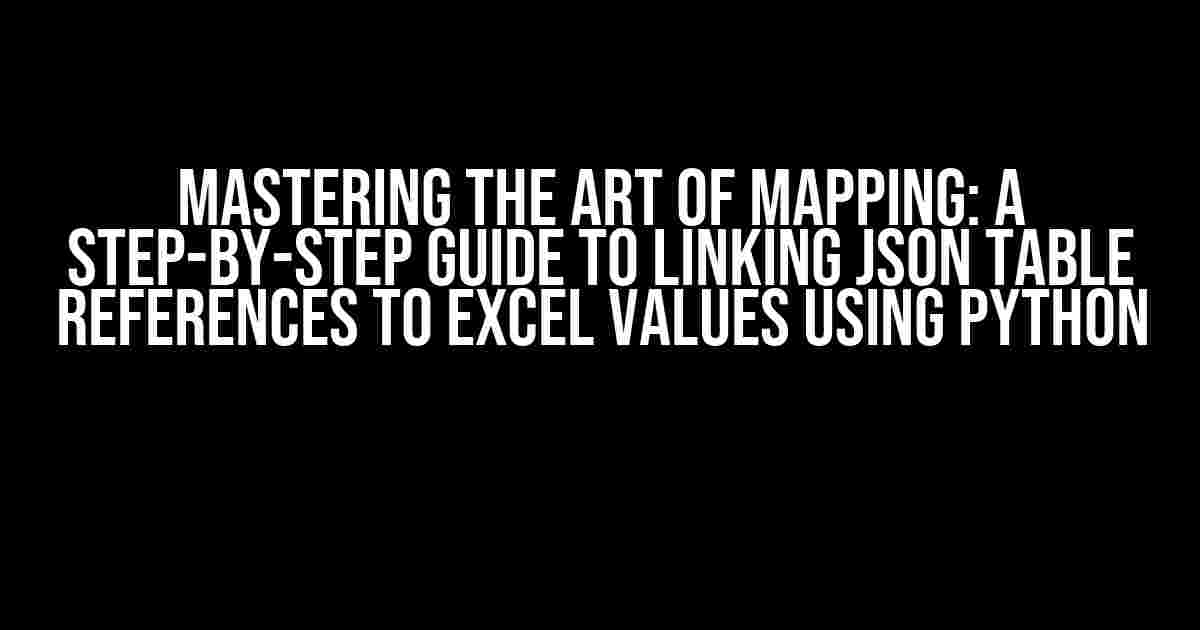Are you tired of dealing with disparate data sources and tedious manual lookups? Do you dream of a world where your JSON files and Excel sheets are harmoniously connected, with data flowing seamlessly between them? Well, dream no more! In this comprehensive guide, we’ll walk you through the process of mapping table references in a JSON file to corresponding values in an Excel file using Python.
The Power of JSON and Excel
Before we dive into the nitty-gritty, let’s take a moment to appreciate the strengths of our two protagonists: JSON and Excel. JSON (JavaScript Object Notation) is a lightweight, human-readable data interchange format that’s perfect for storing and exchanging data between systems. Excel, on the other hand, is the ubiquitous spreadsheet software that’s ideal for data analysis, visualization, and manipulation.
When you combine the two, you get a potent data-processing cocktail that’s hard to beat. But, as we all know, the key to unlocking this potential lies in bridging the gap between these two data formats. That’s where our Python script comes in – a hero that will save the day by mapping table references in JSON to corresponding values in Excel!
Prerequisites and Tools
Before we begin, make sure you have the following tools and libraries installed:
- Python 3.x (the latest version is recommended)
- The
jsonlibrary for working with JSON data - The
openpyxllibrary for interacting with Excel files
If you haven’t installed these libraries yet, you can do so using pip:
pip install json openpyxlStep 1: Load the JSON File
The first step in our journey is to load the JSON file into our Python script. Create a new Python file (e.g., json_to_excel.py) and add the following code:
import json
with open('data.json') as f:
data = json.load(f)In this code, we’re using the json library to load the contents of the data.json file into the data variable.
Step 2: Load the Excel File
Next, we need to load the Excel file into our script. Add the following code to your Python file:
import openpyxl
wb = openpyxl.load_workbook('data.xlsx')
sheet = wb['Sheet1']In this code, we’re using the openpyxl library to load the data.xlsx file into the wb variable, and then selecting the first sheet (assuming it’s named “Sheet1”).
Step 3: Map Table References to Excel Values
This is where the magic happens! We’ll create a function to map the table references in our JSON file to corresponding values in the Excel sheet. Add the following code:
def map_table_references(data, sheet):
for item in data:
table_reference = item['table_reference']
excel_value = sheet[table_reference[0]][table_reference[1]].value
item['excel_value'] = excel_value
return dataIn this function, we’re iterating over the JSON data and extracting the table references (e.g., “A1”, “B2”, etc.). We’re then using these references to retrieve the corresponding values from the Excel sheet and assigning them to a new key in our JSON data.
Step 4: Save the Mapped Data
The final step is to save the mapped data back to a new JSON file. Add the following code:
mapped_data = map_table_references(data, sheet)
with open('mapped_data.json', 'w') as f:
json.dump(mapped_data, f, indent=4)In this code, we’re calling our map_table_references function and passing in the JSON data and Excel sheet as arguments. We’re then saving the resulting mapped data to a new JSON file named mapped_data.json.
Putting it all Together
Here’s the complete Python script:
import json
import openpyxl
def map_table_references(data, sheet):
for item in data:
table_reference = item['table_reference']
excel_value = sheet[table_reference[0]][table_reference[1]].value
item['excel_value'] = excel_value
return data
with open('data.json') as f:
data = json.load(f)
wb = openpyxl.load_workbook('data.xlsx')
sheet = wb['Sheet1']
mapped_data = map_table_references(data, sheet)
with open('mapped_data.json', 'w') as f:
json.dump(mapped_data, f, indent=4)Run this script, and voilà! You’ll have a new JSON file with the table references mapped to corresponding values in the Excel sheet.
Tips and Variations
While this script should cover the basics, you may need to modify it to fit your specific use case. Here are some tips and variations to keep in mind:
- Handling multiple sheets: If your Excel file has multiple sheets, you’ll need to modify the script to iterate over each sheet and map the table references accordingly.
- Dealing with NULL or missing values: You may want to add error handling to deal with NULL or missing values in either the JSON file or the Excel sheet.
- Customizing the mapping function: The
map_table_referencesfunction is a basic example – you may need to customize it to fit your specific data structure and requirements.
Conclusion
And there you have it – a comprehensive guide to mapping table references in a JSON file to corresponding values in an Excel file using Python! With this script, you’ll be able to bridge the gap between these two data formats and unlock new possibilities for data analysis and visualization.
Remember to stay flexible and adapt this script to your specific needs. Happy coding, and don’t hesitate to reach out if you have any questions or feedback!
| JSON File | Excel File | Mapped JSON File |
|---|---|---|
|

|
|
Note: The above table illustrates a simple example of the JSON file, Excel file, and mapped JSON file. The actual data and structure may vary depending on your specific use case.
Frequently Asked Question
Mapping table references in a JSON file to corresponding values in an Excel file using Python can be a daunting task. Don’t worry, we’ve got you covered! Here are some frequently asked questions to help you navigate this process:
How do I read the JSON file and extract the table references?
You can use the json module in Python to read the JSON file and extract the table references. Simply import the json module, open the JSON file, and use the json.load() function to parse the JSON data. Then, you can access the table references using Python’s dictionary-like syntax.
What’s the best way to read the Excel file and access its values?
You can use the openpyxl library in Python to read the Excel file and access its values. Simply import the openpyxl module, open the Excel file using the load_workbook() function, and then access the worksheets and cells using Python’s object-oriented syntax.
How do I map the table references to the corresponding values in the Excel file?
You can create a Python dictionary to map the table references to the corresponding values in the Excel file. Iterate through the JSON data and use the table references as keys, then access the corresponding values in the Excel file using the openpyxl library. Store the values in the dictionary and you’re good to go!
What if the table references in the JSON file don’t match the column headers in the Excel file?
You can create a separate dictionary to map the JSON table references to the corresponding column headers in the Excel file. Then, use this dictionary to access the correct values in the Excel file. This way, you can decouple the JSON structure from the Excel structure and make the mapping more flexible.
How can I handle errors and edge cases when mapping the table references?
You can use Python’s try-except blocks to catch and handle errors when mapping the table references. For example, you can catch KeyError exceptions when the JSON table reference is not found in the Excel file, or ValueError exceptions when the value is not in the expected format. Additionally, you can use if-else statements to handle edge cases, such as when the JSON data is missing or malformed.
Hope this helps you navigate the world of JSON-Excel mapping like a pro!




